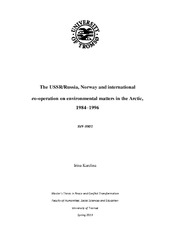The USSR/Russia, Norway and international co-operation on environmental matters in the Arctic, 1984-1996
Permanent lenke
https://hdl.handle.net/10037/5231Dato
2013-05-14Type
Master thesisMastergradsoppgave
Forfatter
Karelina, IrinaSammendrag
This thesis examines the USSR, Norway and international cooperation on environmental matters in the Arctic (1984-1996). During the Cold War, the region attracted much attention from of the main adversaries. It was a playground for strategic planners and a laboratory for the improvement of military technology. But at the same time these territories were also – at least potentially – a source for contacts between scientist of the East and the West. Especially in the last decade of the Cold War, scientists from both blocks more aware of the vulnerability of the environment and the intensification of exploration of natural resources. The Arctic, which was a highly militarized region during the Cold War, can thereby serve a good case to test out the impact of international cooperation.
This thesis considers two main areas: the first area is about the historical development of political relations between USSR/Russia and Norway; Gorbachev’s policies contribution to the development of cooperation in international relations in the Arctic. The second area is about scientific environmental cooperation, which has can be described as transnational in scope and character, and its influence to the political situation in the Arctic.
The thesis based on two theoretical approaches: the so-called “Copenhagen school”, and especially the concept of “securitization” on the one hand, and transnationalism theory on the other. The concept of securitization demonstrates the important transition from military security to environmental security in the Arctic region. Transnationalism shows how the joint the problem of the protection of the Arctic environment managed to bring the international works of scientists, independent organizations, states closer in some aspects.
The thesis is based on case-study, it is qualitative study. It draws on a variety sources, where Russian articles, especially dissertations play a crucial role. The text starts from introduction chapter, focusing on theory and methodology, followed by four chapters and ends with a concluding chapter, which discusses the findings of this work.
Forlag
Universitetet i TromsøUniversity of Tromsø
Metadata
Vis full innførselSamlinger
Copyright 2013 The Author(s)
Følgende lisensfil er knyttet til denne innførselen:
Med mindre det står noe annet, er denne innførselens lisens beskrevet som Attribution-NonCommercial-ShareAlike 3.0 Unported (CC BY-NC-SA 3.0)
Relaterte innførsler
Viser innførsler relatert til tittel, forfatter og emneord.
-
A Driftwood-Based Record of Arctic Sea Ice During the Last 500 Years From Northern Svalbard Reveals Sea Ice Dynamics in the Arctic Ocean and Arctic Peripheral Seas
Hole, Georgia M.; Rawson, Thomas; Farnsworth, Wesley Randall; Schomacker, Anders; Ingólfsson, Ólafur; Macias-Fauria, Marc (Journal article; Tidsskriftartikkel; Peer reviewed, 2021-09-15)We present a 500-year history of naturally felled driftwood incursion to northern Svalbard, directly reflecting regional sea ice conditions and Arctic Ocean circulation. Provenance and age determinations by dendrochronology and wood anatomy provide insights into Arctic Ocean currents and climatic conditions at a fine spatial resolution, as crossdating with reference chronologies from the ... -
A screening for canine distemper virus, canine adenovirus and carnivore protoparvoviruses in Arctic foxes (Vulpes lagopus) and red foxes (Vulpes vulpes) from Arctic and sub-Arctic regions of Norway
Tryland, Morten; Balboni, Andrea; Killengreen, Siw Turid; Mørk, Torill; Nielsen, Ole; Yoccoz, Nigel Gilles; Ims, Rolf Anker; Fuglei, Eva (Journal article; Tidsskriftartikkel; Peer reviewed, 2018-10-26)Canine distemper virus (CDV), canine adenovirus (CAdV) and canine parvovirus type 2 (CPV-2) cause disease in dogs (Canis familiaris). These, or closely related viruses, may also infect wild carnivores. The aim of this study was to investigate exposure to CDV, CAdV and CPV-2 among fox populations in Norway. Arctic foxes (n = 178) from High-Arctic Svalbard were investigated for antibodies against CDV. ... -
Fisheries in the high seas area of the central Arctic Ocean. An analysis of the existing legal regime in the Arctic Ocean
Kristjánsdóttir, Birgitta (Master thesis; Mastergradsoppgave, 2016-09-01)This thesis aims to analyse the existing legal regime in the Arctic Ocean, with particular emphasis on the central Arctic Ocean.


 English
English norsk
norsk



